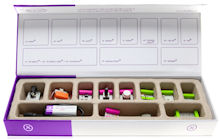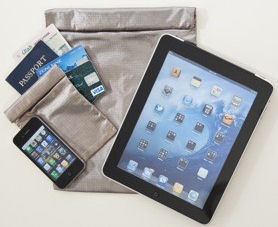The key to constructing complex and interesting things is to take advantage of modularity -- as with walls and doors and windows in construction, objects and routines in programming, or dedicated circuits in electronic devices.
For one example, Lego blocks use the classic interlocking brick design to provide simple and consistent connections for building and combining modules.
And the Logo programming language simplifies learning to program through simple but powerful functions (especially for drawing), combined through small procedural modules.
But even with well-defined modules, trying to get started experimenting and playing in a new area still can be overwhelmingly complicated and confusing -- both in understanding the components, and in the details of how to connect them together.
 Which is why the littleBits electronic modules are such a clever approach for helping people to experiment and learn and play with electronics -- You can assemble electronic projects simply by snapping together small modules.
Which is why the littleBits electronic modules are such a clever approach for helping people to experiment and learn and play with electronics -- You can assemble electronic projects simply by snapping together small modules.
You can have fun quickly making basic designs like buzzers and blinking lights, or check out the littleBits website for a wide range of project ideas from littleBits and its users.
You can quickly snap together a simple light or buzzer, step up to a fun project like a flickering lantern, or interactive card, or move on to a more ambitious project like a motion-based sound generator or simulator for phases of the moon.
What makes littleBits so friendly is that there's no soldering, no wire-wrapping, no stripping wires -- While all of these can be can be fun for enthusiasts, they can be rather off-putting for kids and even grown-ups that just want to get started quickly.
 Instead, each littleBits Bit (individual module) is typically a small 1-inch circuit board with brightly-colored plastic ends. The modules snap together magnetically, so there's no fuss, no way to mess up the hook-up.
Instead, each littleBits Bit (individual module) is typically a small 1-inch circuit board with brightly-colored plastic ends. The modules snap together magnetically, so there's no fuss, no way to mess up the hook-up.
The littleBits Bits are organized in four color-coded flavors by their use, as you chain them together to create your electronic project:
Start with a Power Bit (blue) at the beginning of the chain to supply power to the rest of the modules.
To control the action, add Input Bits (pink) with buttons, switches, and sensors. The touch controls include a button, dimmer, pulse, toggle, roller, and slider. The sensors include light, motion, and sound triggers.
Then to make stuff happen, add Output Bits (green) for light, sound, and motion. These include LED lights such as color, bargraph, and uv, and actions from vibration, motor, buzzer, and fan.
You also can add Wire Bits (orange) to make more interesting creations by separating power and communication between Input and Output Bits. These also include an inverter to reverse signals and logic Bits that take multiple inputs.
Even better, if you want to dive deeper into electronics, littleBits is an open source project, so you can download detailed circuit diagrams of the modules.
You can get going with the littleBits world with kits and bundles, including the Starter Kit with 10 bits for $89 (shown above) and the Extended Kit with 16 bits for $149. There also are Booster Packs for touch controls, lights, or sensors for $49, or you can get individual bits starting at $14.
Plus - littleBits also is offering a discount code for $10 off to Manifest-Tech readers through 9/15/13 -- use http://bit.ly/12r706M.
 Find the littleBits Starter Kit on Amazon.com
Find the littleBits Starter Kit on Amazon.com
 LOKSAK makes better resealable plastic bags -- in a variety of sizes to protect your important papers and valuable electronics from dirt and dust, sand and salt, water and humidity (see earlier post).
LOKSAK makes better resealable plastic bags -- in a variety of sizes to protect your important papers and valuable electronics from dirt and dust, sand and salt, water and humidity (see earlier post).  There's also the SHIELDSAK, a lightweight, fabric Faraday pouch that blocks wireless signals that can access your information.from mobile devices, passports, and credit cards.
There's also the SHIELDSAK, a lightweight, fabric Faraday pouch that blocks wireless signals that can access your information.from mobile devices, passports, and credit cards. ![]() Find LOKSAK bags and the SHIELDSAK on Amazon.com
Find LOKSAK bags and the SHIELDSAK on Amazon.com

 There still can be a need for the original frē case if you're in rougher environments, since it includes a screen protector to take the scratches and gouges that would otherwise reach the glass of the screen.
There still can be a need for the original frē case if you're in rougher environments, since it includes a screen protector to take the scratches and gouges that would otherwise reach the glass of the screen. A better answer is to take advantage of the small size of the microSD card as a common storage media, and then use adapters to fit it into the SD card and USB stick formats -- as in the
A better answer is to take advantage of the small size of the microSD card as a common storage media, and then use adapters to fit it into the SD card and USB stick formats -- as in the  The
The  Which is why the
Which is why the  Instead, each littleBits Bit (individual module) is typically a small 1-inch circuit board with brightly-colored plastic ends. The modules snap together magnetically, so there's no fuss, no way to mess up the hook-up.
Instead, each littleBits Bit (individual module) is typically a small 1-inch circuit board with brightly-colored plastic ends. The modules snap together magnetically, so there's no fuss, no way to mess up the hook-up.